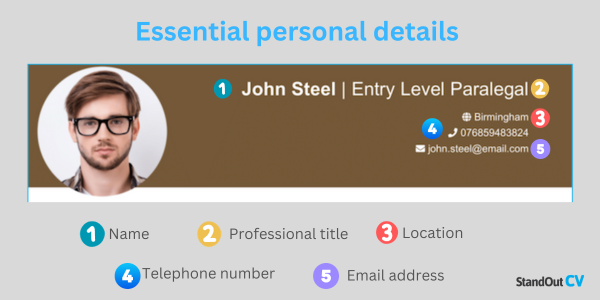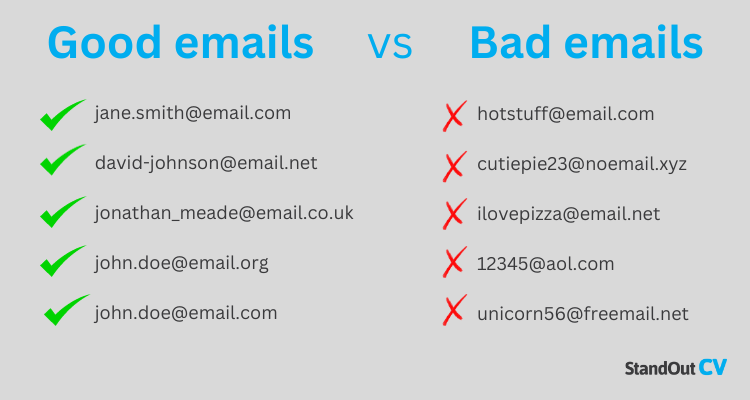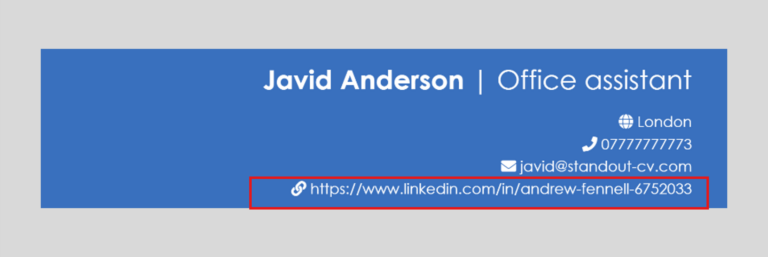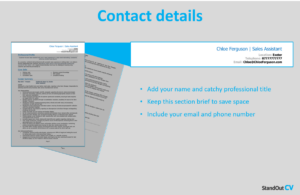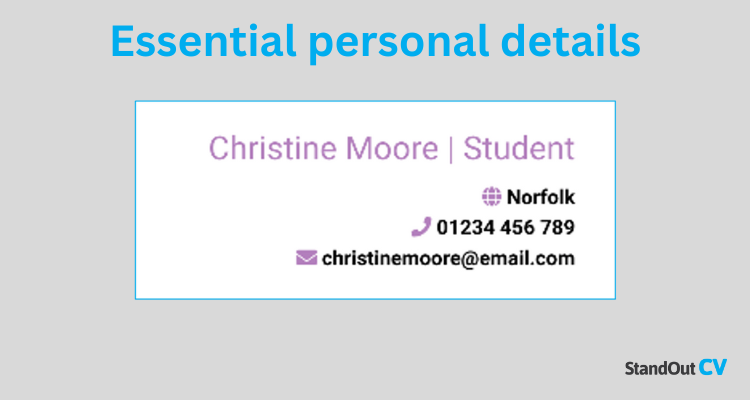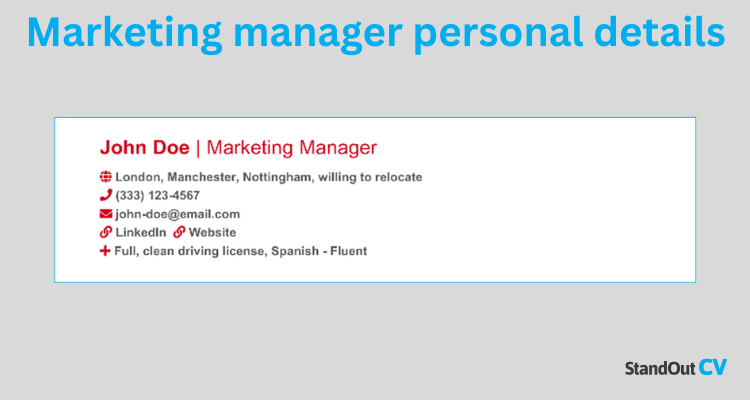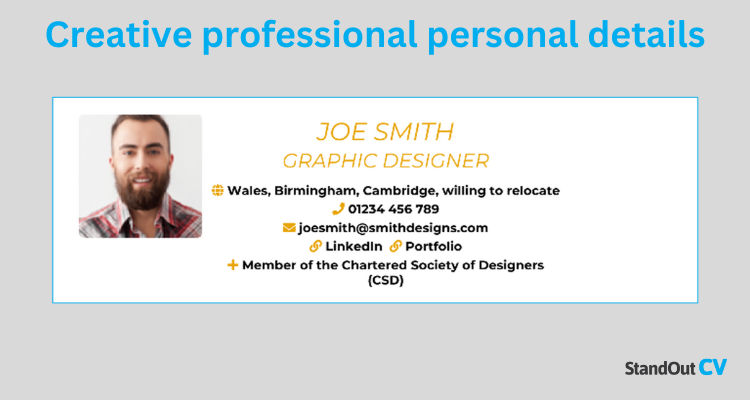Fed up with staring at your blank CV, wondering what personal details to put in?
We get it – it’s like trying to adorn your room with the perfect throw cushion – not a deal-breaker. But it is still important.
In this article, we’ll show you what personal details to include or omit from your CV, plus examples, to boost the chance of hiring managers getting in touch with you.
Contents
What is personal information on a CV?
Personal information on your CV is a list of details about yourself that help recruiters learn who you are, and how to contact you, and can also include links to external sources of information, such as social profiles and portfolios.
Essential personal information to include in your CV
If you want to introduce yourself properly to a hiring manager, the details you include at the very top of your CV are critical.
The essential details that you must always include are:
- Name – Your full name
- Professional title – Your job title (e.g. “Junior Doctor” or “Marketing Director”)
- Location – The general area you reside in (e.g. London, Edinburgh etc.)
- Email address – laura-davidson@email.com
- Telephone number – 01234567890
Full name
Your full name is there so that recruiters know who they can call you by.
Add your name so that recruiters know who you are, but use your real, full name.
But feel free to skip middle names to save precious space.
To make your name catch the eye, opt for a font that distinctly sets it apart from the body text.


Professional title
Your professional title in a CV is your job or career title. Essentially, it summarises your role and experience.
For instance, if you create the text for TV, radio, print, and online ads, your professional title would be Advertising Copywriter.
This gives hiring managers a summary of your primary area of expertise and the sort of roles you’re qualified to do.
Being at the top of your CV, it really helps you to quickly get the attention of recruiters.
For example, the following professional titles can help improve your CV:
- Digital Marketer – Someone who uses digital marketing channels to reach customers, promote services or products, or build brand awareness.
- Software engineer – Showcases your technical prowess, problem-solving abilities, and passion for cutting-edge technology.
- Radio presenter – Demonstrates that you present on a radio station, and have on-air charisma, exceptional communication skills, and the capacity to engage audiences.
- Business student –keenness to learn about management, finance, and marketing.
When writing your professional title on a CV, place it next to or underneath your full name, such as:
- Deborah James | Advertising Copywriter
- Bill Jacks | Software Engineer
Use clear font so that hiring managers can read it. Make it concise so it gives a summary of your primary role and can be read quickly.
Location
The location on your CV is the city or general area where you’re currently based (or where you want to work if you’re applying for a job in a different location.)
Your location details help hiring managers figure out where you’re based so they know the proximity to their company and whether or not you can commute to their office.
Getting your location right is very important because if a hiring manager doesn’t think you live too far away from them, they won’t consider your application
Here are some examples of how to write locations on your CV:
- Edinburgh
- London and Kent
- Leighton Buzzard (Willing to relocate)
To include your location in a CV, place it near your full at the top.
A quick tip: You don’t need to include your full address, such as street name and house number, because it is too much information for this stage of the recruitment process and it will take up a lot of valuable space – it’s just about providing them with a general sense of your location.
Contact number
The contact number on your CV is the phone number that lets potential hiring managers or recruiters get hold of you about the job you’re applying for.
For instance, if your phone number is 07777777777, you’d usually write it like this: Phone: 07777777777, or use a telephone symbol.
Here are some examples of how to present phone numbers on your CV:
- Phone number: 10575598623
- Telephone: 01234 567 890
- ☎: 07777777777
When it comes to writing your contact number, place it below your name and location. Use the same format as the rest of your CV, but it’s a good idea to make it a little larger, bolder or in a different font to make it stand out.
When writing your contact number on a CV, make it clear, make it easy. It’s how employers can easily reach out to you to arrange interviews, discuss job offers or ask questions relating to your application.
Triple-check that the number is correct, or you will not be getting any calls from recruiters.
Email address
Your email address is a critical piece of contact info on your CV so that would-be employers can reach you regarding your job application. It’s where all those job offers and interview requests land.
Your CV is a professional document, so your email address should look professional to reflect this and create a good impression.
Your full name, or a close variation of it, will work best.
Here are some examples of good email addresses to include on your CV:
- johnsmith@email.co.uk
- sarah.davidson44@email.co.uk
- shaun-clarke@email.com
But beware of the bad ones! Avoid email addresses that may make hiring managers raise an eyebrow, like crazydoglover@email.com or partygal@email.com. While these might be fun with friends, they don’t look professional on your CV!
Formatting-wise, place your email address directly under your contact number. Be sure to use the same font style as the rest of your CV. However, you can make it slightly bigger or bolder to give it more emphasis.


Optional personal CV details
Think of the optional personal CV details as extra choices – they’re not mandatory.
There are certain personal details to get in your CV, but only for specific countries, jobs, locations, and industries.
That said, they don’t necessarily make a CV better.
Let’s say you’re applying for a job where driving is an essential element. You could mention your driver’s license, as it shows your dependability and mobility for roles that entail travel or client meetings.
Profile photo
Including a photograph on your CV can have benefits and drawbacks. But it can significantly impact your CV’s overall impression.
Using a photograph in your CV is optional – they are not always needed, but some regions and industries like to see them.
While social media profiles may benefit from a headshot, CVs are mostly about your experience and abilities, not your smile.
In numerous regions, like the UK, hiring managers don’t often request photos because of anti-discrimination laws.
But in certain countries, such as Europe, Asia, the Middle East, and parts of Africa, it’s common to include a profile photo on a CV, particularly in industries where how you look and present yourself matters a lot.
In creative fields like modelling, acting, and fashion, a photo isn’t just accepted but often desired. It enables you to put forward your one-off look, style, and appropriateness for positions where appearance is fundamental.
If you choose to include a photo on your CV, here’s how you’d do it:
- Keep it professional – Pick a professional-quality headshot where you’re dressed suitably for your industry.
- Keep it friendly –Maintain a confident, friendly smile and use eye contact.
- Top corner – Position your photo in the top left or right-hand corner, ensuring it’s small and discreet.
- Layout consistency –Make sure your picture complements your CV’s design in style and colour.
- Avoid selfies – Ditch selfies or group shots – plump for top-quality solo photos.
- Revise regularly –If your appearance changes, update your headshot for accuracy.
Driving licence info
Certain jobs are about hitting the road and having your driving licence info can make a huge difference as it shows you can legally drive.
Think sales representatives, delivery drivers, or couriers.
And if you’ve got a professional license, like a forklift, motorcycle or Heavy Goods Vehicle (HGV) credentials, be sure to flaunt it – it could unlock doors to exclusive job opportunities.
To include it, reserve a neat place at the top of your CV underneath your telephone number where you note the licence and its status. It could literally make the difference between getting the job or not in some cases.
LinkedIn profile
Your LinkedIn profile is a hyperlink that leads hiring managers to your LinkedIn profile, a professional networking platform.
It allows recruiters and employers to take a peek at your career history, see how many connections you have, and even check out recommendations from other professionals.
Dropping that link to your LinkedIn profile offers quite a few plusses.
You’re not only revealing your abilities and endorsements. You’re also rolling out the red carpet for recommendations from your co-workers.
Because let’s face it. It’s all about upping your professional image, right?
Adding a quick URL to your LinkedIn profile can be a real gem for industries like marketing, sales, consulting, tech, and finance.
Why? In these industries, developing robust professional relationships and extending your network is paramount in terms of balancing your career and boosting your credibility.
A quick tip: Keep your LinkedIn profile up to date and ensure you have plenty of recommendations to show off. After all, you want to make the right impression!
Personal portfolio or website
If you have a personal website, online portfolio or blog that showcases your work, this can be great for showing employers you have the right skills for the job.
It can be especially powerful if you’re in a creative field such as graphic design, photography or writing – or any profession where visual or tangible examples of your work can boost your job application.
Add a short link near your contact details, so that it is easily accessible.
Language skills
If you speak any foreign languages, it’s certainly worth mentioning them.
Including these skills at the top of your CV can be super handy for hiring managers who need specific language abilities, adding a colourful feather to your professional cap.


Personal details not to be included on a CV
When you’re adding personal details to your CV, keep in mind that some details, such as your marital status, present salary, and religious faith, are not usually going to impact a hiring decision – so it’s best to keep them out.
Here’s what personal details I would recommend keeping out of your CV…
Previous or present salary
Disclosing your current salary can occasionally lead to a mismatch in expectations.
It may harm your chances of getting a higher salary when it comes to salary negotiation.
Let’s say you initially revealed a lower figure, only to discover that the offer on the table was significantly greater.
So, leave the salary talk off your CV – it’s a conversation best had at a later stage.
Marital status
Marital status is your existing official relationship status in terms of marriage. For example, it usually includes categories such as Married, Single, Divorced, Widowed, and Separated.
Your CV isn’t a dating profile. So, there’s no need to include your marital status here.
Hiring managers only want to know about skills that go beyond your relationship status. Your qualifications are what count here.
Religious faith
Unless you’re applying to be the church’s official organist, don’t include it. It’s like saying what hair colour you want your waiter to be in a restaurant – not relevant.
Most hiring managers don’t care about this stuff, and divulging it may even open doors to unwanted prejudice.
So, keep your religious beliefs close to your heart and your CV free from religious info.
Date of birth
Skip the birthday candles on your CV – recent anti-discrimination rules mean hiring managers should concentrate on your talents, not how old you are.
The bonuses of omitting it? Less possibility of age bias, more space for the good stuff, plus lower identity theft risk.
Disability or health issues
There’s no need to spill the beans about your physical or mental health on your CV.
If your ailment entails some additional support, for example, if you’re a wheelchair user, you could mention it in your cover letter or through a chat with the recruiter or hiring manager.
Many moons ago, people used to include their health status in jobs like physical fitness trainers or swimming teachers, but this isn’t the case anymore.
Gender
But there’s no real reason to indicate your gender in your CV, as it won’t have a bearing on your job skills. It’s also a waste of CV space and distracts from the important stuff (like your skillset).
And honestly? Your name usually gives your gender away anyway.
National insurance number
Your National Insurance Number (NI number) is your unique identifier if you’re based in the UK for tax and social security purposes.
This number is like your secret treasure map – you don’t want anyone to come across it.
To stop identity theft, the UK government suggests keeping it somewhere safe and not sharing it unless you absolutely must.
So refrain from splashing it on your CV for everyone to see. Once it’s out there, it’s tricky to regulate who gets their hands on it.
Nationality or ethnic group
There’s no need to include your nationality or ethnic group on your CV unless you’re a foreign national and want to tell the hiring manager about your work eligibility in the country.
Just something simple like “Spanish, eligible to work in the UK” should do the trick.
A quick tip: If you’re applying for a government role where citizenship matters, like civil service or secret agent positions, it’s okay to mention your nationality here.


How to write personal details on a CV
If you want to add personal details to your CV, this is how you’d do it.
- Position at the top –You want your personal details to sit right at the top of your CV so its easy for recruiters to see how to contact you.
- Keep it compact – You have limited space on your CV, so keep this basic info tucked up into a top corner
- Use icons – Create a professional appearance and use space wisely by using icons to denote these details (Like a phone icon for your phone number)
- Hyperlink to external sources– If needed, add optional links such as your online portfolio or LinkedIn profile.
3 personal details examples on a CV
Here are three examples of how your personal details should be laid out on a CV.
The first example is for someone with basic details, like an office worker, the second is for a creative person who may need a few more, and the last is for someone who operates vehicles who may require even more.
Essential personal details
If you’re a student studying at school, college or university, you want to make it super simple for hiring managers to reach you.
Inserting your name, professional title, location, phone number, and email isn’t just a mere formality – it lets prospective employers initiate contact with you. It also allows them to confirm your background, and start the conversation.
Marketing manager’s personal details
A Marketing Manager is like a creative champion of a company, driving the marketing approach. They plan brilliant campaigns and ensure the brand’s voice gets heard loudly and clearly.
As well as including the essentials like your name, contact info, and where you live so that hiring managers can get in touch easily, remember to mention your LinkedIn and personal websites here, too.
You could even include your driver’s license and language skills to show you’re all set for various tasks.
Creative professional personal details
Creative professionals infuse life into concepts via design, art or other imaginative approaches.
For instance, a graphic designer crafts visual elements for all media types, from elaborate illustrations to eye-catching posters, iconic logos, and web graphics.
So, as a creative professional, it’s important to include your LinkedIn and personal website, as these serve as virtual portfolios, showing more about your artistic work.
In your personal details, consider adding a profile photo – this shows hiring managers you look professional, which is paramount for numerous jobs.


Where to put personal details on a CV
You need to place personal details at the top of your CV at the beginning. That way, recruiters can’t miss them and you’ll be on their radar from the start.
Placing these personal titbits at the top of your CV makes it super simple for hiring managers to spot and drop you a message if they’re keen on having a chat.
How to format personal details
In terms of formatting your personal details on your CV, here’s how you’d do it:
- Highlight your name – Make your name the star of the show. Use a larger font or put it in bold to ensure it grabs instant attention.
- Right-align or centre-align – So that your personal details turn heads, right-align or align them centrally at the top. Doing so gives your CV a smart appearance so the reader can easily navigate it.
- Bold for visibility – Use bold text for all personal details to help them stand out amid the rest of your CV’s text.
- Size counts – Choose an 18 to 20-point font size for personal details like your full name, telephone number, location, email address, and optional LinkedIn or online portfolio URL.
The takeaway
While adding personal details on your CV may sound like a trivial detail, they’re your first opportunity to introduce yourself to a potential employer.
Start with strong essential personal details: name, contact details, and location. Then tailor with optional extras (if needed), like a LinkedIn URL or profile photo, to the job’s specific requirements.
Skip them, and you could leave hiring managers with an unfinished picture of your credentials and suitability for the job.



